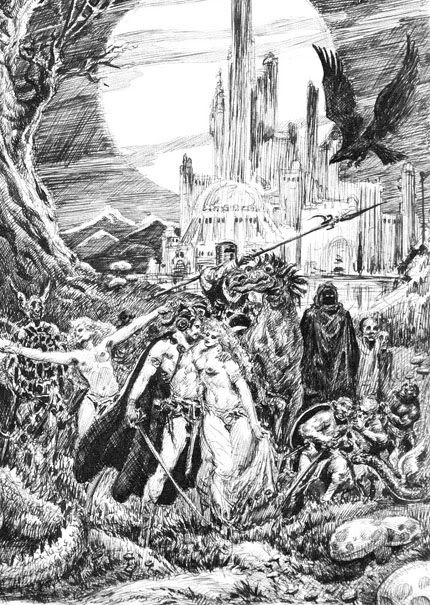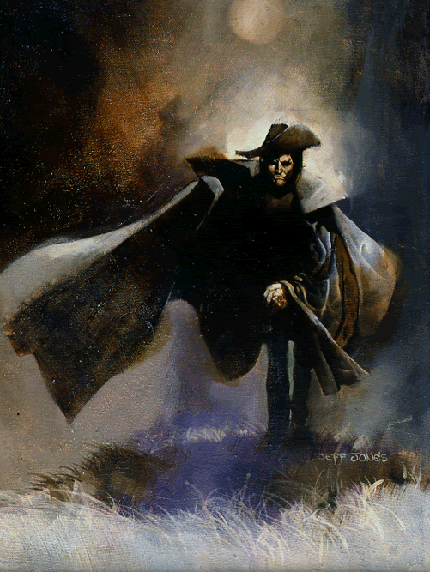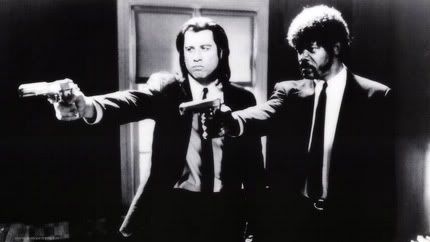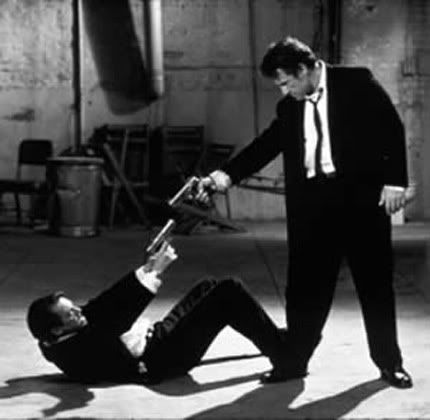
The Wyrm of the Old Forest.
Dragons ravage, plunder, and devour in accordance with their cruel and avaricious natures. A pox upon the lands they stalk, they are never the less, generally understood to behave in a given manner. They can be fought by those who study and learn their motives, powers, and weaknesses. The same may not be said of the Wyrm of the Old Forest.
A monster of myth and a living fear of the unknown, the Wyrm comes and goes when it will. Sometimes leaving evidence of its passage, and sometimes not. The stories of the Wyrm are often vague and frustratingly contradictory. In some it is described as simply a ravening beast without thought, while in others the Wyrm asks probing and erudite questions of its captives. Various tales paint the Wyrm as a great serpent, as long as three galleys end to end, or as merely horse-sized. Some times it is spined and finned, sometimes with limbs, while others say it has none. Chrueleam the Lame, Boccob ward his soul, held that the Wyrm is more than a material creature, or perhaps less. The true nature of the Wyrm may never be known. Of the many who have sought it over the years, the majority have simply failed to find it at all. Often, decades pass between sightings of the creature. It would seem the Wyrm chooses the time and place, as well as the manner of its rare meetings with those who seek it, as well as those who do not. The Wyrm has been thought slain more than once, only to reappear inexplicably years later. The tales of encounters with the great drakonish serpent span many centuries, and offer conflicting accounts of its weird behavior, changing appearance, and inscrutable motives.
The Old Forest is itself a dread place of a character ancient and fey. The gloomy boles march on for leagues, giant trees which shroud the forest floor in eternal twilight and mute the sound of the wind to an eerie susurrus. This place is tacitly acknowledged by all as the domain of the Wyrm. Even the greatest of dragons respect the territory of the Aulde Serpent. More than one arrogant drake is said to have met its end in the iron coils of the Wyrm. The peasants who till the lands about the periphery of the Old Forest venture within it only in need. They gather what they must have with speed and deference and return to the sunny fields as quickly as they may. Ill sendings sometimes fall upon those who stay beneath the verdant canopy for too long, or who demand too much of the grim greenwood.
The Riff of Lurding Run and four of his men at arms were reportedly slain and devoured when they ventured into the Old forest in pursuit of an outlaw. The surviving armsmen told a wild tale about a monstrous snake with arms like a man and black eyes like pits, which fell on them as they stalked the criminal and which tore the Riff’s head from his shoulders with its clawed hands. A fisherman on the river Qwelling, which flows through the southern corner of the Old Forest, related to his fellows how he was watched from the shore by a beast he could not see for the shadows of the trees, but who’s eyes were large as an ogre’s fists and shone redly from the darkness. It is whispered that the daughter of the Baroness DurJaent was born with a cap of feathery, jewel toned scales adorning her head instead of fine coppery hair. The Baroness had earlier traveled by night through the Old Forest on her way to Kelb. As the child was sequestered, and the midwives killed, only the Baroness herself knows the truth behind the rumors, and no one has thus far been fool enough to ask her.
Procelleus of Nmand claimed that the epiphany which resulted in his Grand Arcanology came to him as a result of an exchange at a crossroads deep within the Old Forest betwixt himself and, “an ancient serpent of tremendous size, frilled and finned, with green-black scales and eyes that shone as like portals to the Hells.” After the words were done with, the Wyrm demanded but one of Procelleus baggage carriers as a toll for passage and wisdom. Said Procelleus on the matter, “as the man was a sluggard and suspected of thievery his fate weighed not so heavily on my mind.”
It was reported by a group of traveling players that they awoke during the night to find an enormous serpentine body encircling them on all sides, a veritable wall of gleaming black scales as thick as a bull just at the periphery of the light cast by their campfire. So large was the snake that they could see neither its head nor its tale. In utter terror, the actors prayed to the gods of the stage for deliverance and finally, as dawn neared, the great serpent moved off into the forest. As all actors are liars, the truth of this is uncertain, though many tales do seem to indicate the Wyrm is drawn to fires in the night.
The peasants and serfs who live near to the edges of the Old Forest will on occasion drive a sheep or goat into the woods to appease the Wyrm, should the signs indicate the wisdom of such action. Many such customs have grown up in the areas about the Old Forest. Travelers will notice shrines with serpentine motifs beside trails and roads. The rustics leave gifts meant to placate the Wyrm and earn its disregard, if not its favor. Wards against the serpent are carved on door lintels and gates. More than a few of the villages and thorps nearby the Old Forest hold annual rites believed to mollify the Wyrm, some of these rituals are darker than others. The Wyrm seems rarely to roam far from the forest, but appears not to be bound to it in any way. In a few tales the Wyrm has been seen many leagues from the borders of the Old Forest. It was the Wyrm which legend says brought down the bridge of Cusrus and toppled the Tower of Nul.
Ahriplagupulus, the Master Tanner of Glumn, is said to have stuck to his tale of meeting the Wyrm even when put to the question by the Enlighteners. The tanner insisted that he was not so very drunk when he found the Wyrm half inside his sheep barn and engaged in devouring some of his choicest ewes. With spirituous, if not spirited, courage, he demanded payment for his losses from the ancient serpent. It is the testimony of Ahriplagupulus that the Wyrm regarded him coldly for thirty heartbeats, and then vomited up the corpse of Ahd the Rivener. The Wyrm bade the tanner strip the bejeweled armor from the dead man as compensation for the sheep, and then, when he had done so, again swallowed up the body and simply faded from view and was gone. To test the truth of his assertions, the tanner was bound to a board and dunked in a well until he drowned. There was some understandable unrest, as the tanner was well liked by those who knew him. The Enlighteners were unmoved by the peoples protests, maintaining that mankind is perpetually at war with the unknown terrors of the night, and in this war against the terrors, innocents must sometimes, unfortunately, be sacrificed.
One rarely told tale tells of a place in the Old Forest where it is sometimes possible to converse with the Wyrm in relative safety. A huge drum of fluted stone, called the Plinth of Terrible Wisdom, lies half buried in the loam of the forest floor. It would seem to once have been a part of an enormous building column, but no other evidence of a structure remains nearby. The Plinth is 20 feet across, and 12 feet of it projects above the ground. Atop the stone cylinder, the surface is inscribed with the image of a serpent which encircles the stone and grips its tail in its mouth. The legend states that if a person stands upon the Plinth in the dark of the moon and calls to the Wyrm with its true name, it will slither forth from the night and willingly speak with the caller. So long as the caller does not leave the Plinth, the Wyrm will not attack. So the tale goes. None who now live can confirm the facts, so those who would speak with the Wyrm in this manner risk their lives and dare the Fates.
The Wyrm of the Old Forest.
AC: -2, HD: 16, (128 hps), MV: 12”, (120 feet per round), No. of Attacks/Damage: 2/2D6, (bite), 2D12, (Constriction), Special: Venom/Breath Weapon/Charm
The Wrym is a titanic serpent over 140 feet in length. Along its back, spiny fins or sails project at irregular intervals. Its scales are a deep greenish black, and its eyes reveal an intellect ancient and malign.
The Wyrm takes no damage from non-magical weapons. It is immune to Charm and Hold spells.
The Wyrm possesses a power of fascination. Anyone who listens to the Wyrm speak for more than 3 rounds must Save VS Magic or be entranced by it. The Wyrm may then lay a Geas upon the victim, commanding them to perform a service, or bring it an item or sometimes a person.
The Wyrm possesses a dragon-like breath weapon, but may use it only once per day. The Wyrm may breathe forth a billowing cloud of scintillant mist. The mist fills a cone shaped area 60 feet wide and 60 feet long. All things exposed to the mist, living or not, age 16d10 years if they fail to Save VS Breath Weapon.
There is a 50% chance of spell failure which affects any casting performed within 300 feet of the Wyrm. This chance of failure is lessened by 10% for every level over the tenth of the caster. This is something which is inherent in the Wyrm and not a power which it may direct.
The Wyrm’s great fangs inject a powerful venom which requires the victim to Save Vs Poison at -2 or die immediately. Those who manage to evade death must still suffer the venom’s secondary effects. There is a 25% chance of madness, of the variety which results in terrible hallucinations and violence. There is also a 25% chance of Enfeeblement, as the spell, and a 50% chance of a reoccurring transformation. Roll 2d10 to determine which of the secondary effects the victim incurs.
If the victim suffers the reoccurring transformation, then at each dark of the moon hence, he will transform into a man-serpent in all respects identical to an Abomination of the Yuan-Ti. In this form, the victim will be filled with insensate rage and bloodlust, and until dawn breaks, will attempt to kill all creatures that it encounters. A Remove Curse may, 40% chance, end the cycle of transformations. If this fails to stop the changes, the only option remaining is to convince the Wyrm itself to lift the curse. It may well be willing to do this; its motivations are convoluted and veiled. It has been said that bathing in the blood of the Wyrm will also end the transformations, but as no one has ever succeeded in doing so, the truth is uncertain.
If it successfully hits with its bite, the Wyrm may coil about and constrict an opponent if it chooses. This it generally only does with Larger than Man-Sized opponents. A victim ensnared in the coils of the Wyrm must have strength equal to that of a Frost Giant to have any chance of breaking free.
-----------------------------------
The Wyrm is one of my Monsters, capital M, a unique creature that does not necessarily have to abide by the rules of monster, little m, creation. These stats are not set in stone,and if you'd like to use a version in your own game, by all means do so.
You can use the Wyrm as a simple monster for combat, but the idea is to replicate the vague fear of the unknown that the Monsters of fairy tale and myth inspire because no one agrees on their definitions or limits.
Players should be unsettled by dealing with a thing which may not follow the expected rules, but you can't do this sort of thing all the time, or they'll accuse you of being arbitrary and unfair.
Monsters like this are best used in campaigns with players who relish the feeling of danger and immersion that mythic backgrounds create. The fun of a creature like the Wyrm is not just in fighting it, but in the connection it makes with the past history of the game world. It make the players feel their characters are a part of the world they inhabit to have them interact with features, such as a legendary Monster, that existed before them, and will exist after they've gone to that great character folder in the sky.









